Personal Flotation Device
Life Jackets
There are five types of traditonal foam flotation devices. Each is designed for different boating activites and water conditions and has its own maximum buoyancy, performance level, and limitations. You should choose your life jacket based on your boating activities and conditions, as recommended below. Buy a life jacket that you will wear.
Try to buy a brightly colored jacked, such as orange or yellow, so that you will be visible to rescuers. Take it out of the plastic, try it on, and learn how to adjust it for a snug fit. Then, test it in the water, make sure your life jacket supports you and keeps your mouth and head clear of the water with no effort on your part. Then, try pulling it on once you're in the water...it's not as easy as it seems.
Manufacturers include valuable information about each PFD on the product label, and in an attached brochure. The label will give you information about what uses the jacket was intended for, along with information about the size of person it will fit, care instructions, and how to wear or 'don' the jacket. Keep in mind that using the jacket outside of its listed restrictions and intended use is illegal, and can result in receiving a ticket--or more importantly, the loss of a loved one.
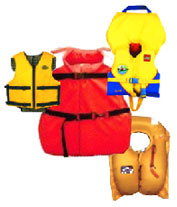
What you would find on a typical life jacket label
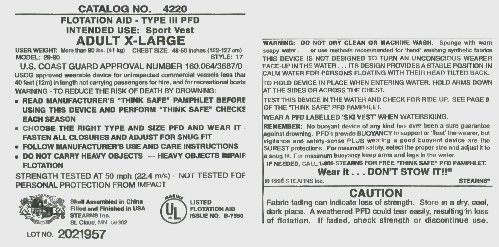
When Should You Wear a Life Jacket?
In general, the best time to wear your lifejacket is when you are near the water. Accidents happen...both on the dock, and on quiet, still waters. In fact, most boating fatalities occur when the boat is moving slowly or not at all. If you feel comfortable without a life jacket on during calm conditions, always keep your eye on weather and water conditions as they can deteriorate very rapidly. While you should always wear your PFD, it is particularly important to wear your PFD during the following times:
- Boating at night, or at times of reduced visibility - When it is hard to see, it will take that much longer to find you if you fall overboard.
- In congested waterways - Many boats and turbulent water might make it difficult to see you in the water. Wearing a PFD will get you higher up, and the jacket colors should make you easier to see.
- When you are by yourself - If you boat alone, there's generally no one around that can help immediately.
- If you boat in rough weather - Difficult sea conditions make for difficult rescues.
- If you boat in hazardous waters - Hydraulics near dams, or in places with strong currents/cold water--even if it's sunny and warm--can make it difficult to rescue you quickly.
Even if you avoid these situations, if you are on an unfamiliar boat, or in unfamiliar waters, you should strongly consider wearing your life jacket. By law, recreational vessels must carry a properly fitted, serviceable PFD for every person on board. Jackets must also be of the correct size for the person wearing it, and you must have life jackets READILY AVAILABLE for use. That means they shouldn't be buried in a locker under a pile of gear, or still in their packaging. Have them out, and ready for use. Better yet, wear them from the start!
What is Buoyancy and Why is it Important?
Buoyancy is the force, expressed in pounds, required to keep you afloat with your head and chin above the water. Since everyone's buoyancy requirements are different based on size, weight, sex, age, percent body fat, and general physical condition you should test your life jacket in the water to make sure it will offer you maximum performance when your life depends on it.
TYPE I - Inherently Buoyant
Recommended Uses
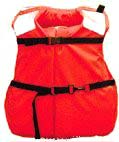
- When cruising, racing and fishing offshore, or in stormy conditions.
- Minimum buoyancy: 22 lbs. (11 lbs. for child size).
- Best for open, rough or remote water where rescue may be slow to arrive. Will turn MOST unconscious wearers face-up in water.
- Offers the best protection, but is somewhat bulky and uncomfortable. Does the best job of retaining body heat, as it has additional foam and fabric, and keeps your head higher above water.
TYPE I - Inflatable
Recommended Uses
- Minimum buoyancy: 34 lbs.
- Recommended Uses: offshore cruising, racing, fishing.
- Will turn unconscious wearer face-up.
- Advantages: two inflation mechanisms, both manual and automatic; very comfortable to wear.
- Disadvantages: requires periodic maintenance; not suitable for whitewater, for use with personal watercraft, or while skiing. So expensive that there currently aren't any Type I inflatable PFD's available to the general public.
TYPE II - Near-Shore Inherently Buoyant
Recommended Uses

- When cruising, racing and fishing offshore, or when boating alone, or in stormy conditions.
- Minimum buoyancy: 15.5 lbs.
- Good for protected, inland water near shore, where chances of immediate rescue is good. Not suitable for extended survival in rough water. Will turn SOME unconscious wearers face-up in water. Poor performer in rough water, often requires you to tread water in order to keep your head above water.
- More comfortable but less buoyant than Type I. Provides far less floatation than a Type I.
Type II - Inflatable
Recommended Uses
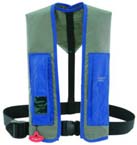
- Minimum buoyancy: 34 lbs.
- Recommended Uses: inland cruising, dinghy sailing and racing.
- Not guaranteed to turn unconscious wearer face-up.
- Advantages: very comfortable, more buoyant than Type II Inherently Buoyant jackets.
- Disadvantages: High price , may be manual or automatic.
TYPE III - Flotation Aid Inherently Buoyant
Recommended Uses

- Supervised activities, such as sailing regattas, dinghy races, water skiing, fishing, canoeing, kayaking and during personal watercraft operation.
- Minimum buoyancy: 15.5 lbs.
- Good for protected, inland water near shore, where chance of immediate rescue is good.
- Not suitable for extended survival in rough water. Not designed to turn unconscious people face up in water.
- Most comfortable to wear than a Type I or a Type II, but provides far less floatation than a Type I.
Type III - Inflatable
Recommended Uses

- Minimum buoyancy: 22.5 lbs.
- Recommended Uses: supervised activities such as sailing regattas, dinghy races, canoeing.
- Not guaranteed to turn unconscious wearer face-up.
- Advantages: more comfortable than a Type III Inherently Buoyant jacket.
- Disadvantages: one manual inflation mechanism only.
TYPE IV - Throwable Device Inherently Buoyant
Recommended Uses
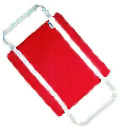
- Throw to overboard victim or to supplement the buoyancy of a person overboard. It is not to be worn.
- Minimum buoyancy: 16.5 lbs. for ring buoy or 18 lbs. for boat cushion.
- Can be a cushion, ring or horseshoe mounted on deck.
- For calm, inland water with heavy boat traffic, where help is always nearby. Not for unconscious persons, non-swimmers or children. NEVER to be used as a seat cushion! This degrades the foam and reduces the amount of floatation that is provided.
- More comfortable than a Type I or a Type II, but provides less floatation than a Type I.
Note
Type IV devices must be IMMEDIATELY AVAILABLE for use. You must have one at arm's length to throw over the side in an emergency. Having one in a locker under the driver's seat isn't considered "immediately available."
TYPE V - Special Use Device
Recommended Uses
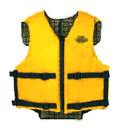
- Restricted to the special use for which each is designed, for example: sailboard harness, decksuit, commercial white water vest or float coats.
- Minimum Buoyancy: 15.5 to 22 lbs.
- Good for protected, inland water near shore, where chance of immediate rescue is good.
- Not suitable for extended survival in rough water. Not designed to turn unconscious people face up in water.
- More comfortable to wear than a Type I or a Type II, but provides far less floatation than a Type I.
Type V - Automatic Inflation Models
Recommended Uses
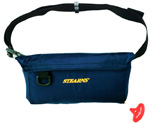
- Minimum buoyancy: 22.5 to 34 lbs., depending on style.
- Restricted to the one use for which it is designed, ex., sailboard harness, belt pack, deck suit, float coat.
- Must be worn to meet federal requirements.
- Not guaranteed to turn unconscious wearer face-up.
- Some models feature a combination of CO2 inflation and built-in foam and provide 15.5 to 22 lbs. of buoyancy.
Type V: Hybrids
Recommended Uses
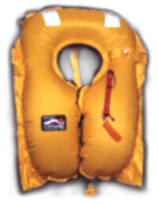
- Recommended for boating activities where rescue is nearby and must be worn when underway.
- Minimum buoyancy: Have 7.5 lbs. of built-in foam buoyancy and can be inflated to 22 lbs.
- More comfortable to wear than Type I or Type II, but are inadequate for unconscious overboard victims.
Inflation Mechanism
When activated, a CO2 cartridge is pierced, releasing gas to inflate the device. Water-activated models inflate automatically when submerged in water. Manual units are activated by yanking a pull-tab. Both types of inflatables feature blow-tubes to provide a back-up method of inflation. It is important to follow the manufacturer's instructions for checking and maintaining your inflation mechanism.
Maintenance
Inflatable life jackets require more frequent maintenance than inherently buoyant life jackets.
- Check the status of the inflator to be certain cartridge is properly installed.
- Check for leaks every two months; inflate life jacket orally and leave it overnight to check for leaks.
- Immediately replace any spent CO2 cartridges with new ones.
- Frequent users of inflatables should check them often, especially if used around sharp equipment like fishing gear.
Inflatables are NOT recommended for individuals who cannot swim (unless worn inflated) and are not for use where water impact is expected, like water skiing or riding a jet ski.
Life Jackets and Kids
A life jacket is no substitute for adult supervision of children in and around the water. Children float differently than adults. Because their body weight is distributed differently, children are more likely to float face down in the water. Children's life vests should have a crotch strap and a neck collar for the most protection.

Youth PFD Wearing Requirements
As of January 1, 2006 there are 48 states and territories that mandate that children wear life jackets while on a boat under certain circumstances. As of December 2002, if you boat in one of the states without a children's PFD regulation, you are required to have all children under 13 wear a PFD while under way, unless they are below deck or in an enclosed cabin while boating on federal waterways.
This list does not include requirements for PFD usage while riding on a PWC or on a towed device such as skis or an inflatable tube.
Care and Storage of your Life Jackets
- Stow life jackets in an accessible place. Life jackets that are stored far from where everyone sits, or under gear are virtually worthless in an emergency. The USCG requires that wearable life jackets be READILY ACCESSIBLE AT ALL TIMES. Also, on boats over 16 feet, at least one Type IV throw-able device must be IMMEDIATELY AVAILABLE.
- All kids should wear a properly fitted and correctly sized, bright, life jacket. Adults, for that matter, should set the example for children by wearing a life jacket.
- Families should mark each life jacket with the person's name and store them facing up.
- Teach your children how to put on their life jackets. Make a game or race of putting a life jacket on. It's the best way for children--and adults, to learn how to don a life jacket quickly. To make it more difficult, try putting them on in the water--it is far harder than you might think!
How to Care for Your Life Jackets
Do:
- Check your life jackets at the beginning of each boating season.
- Check that all hardware and straps are in good shape, are firmly attached, and are in working order.
- Check for leaks, mildew, lumpy or hardened buoyancy material, and oil saturation in the fabric.
- Make sure that there are no rips or tears in the fabric.
- Make sure that the label stating USCG approval is attached, and that it is readable.
Don't:
- Don't use a life vest or throwable flotation cushion as a kneeling pad or boat fender.
- Don't use harsh detergents or gasoline to clean it.
- Don't remove any labels, straps or buckles.
- Don't sew ANYTHING onto the life jacket!
Storage:
- Store in an area with good ventilation.
- If wet, allow it to dry thoroughly in open air before storing.
- Drying it in a dryer, in front of a radiator, or other source of direct heat will destroy its buoyancy.
The amount of buoyancy (and life-saving value) your life jacket provides will decrease over time.
Treat your life jacket as if your life depends on it!

